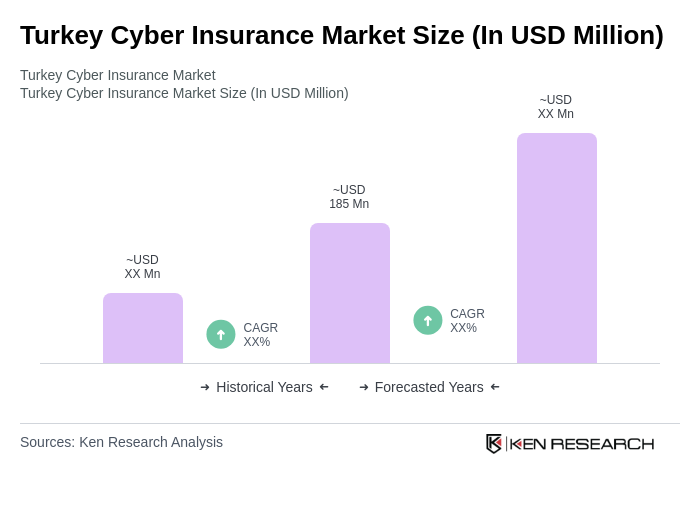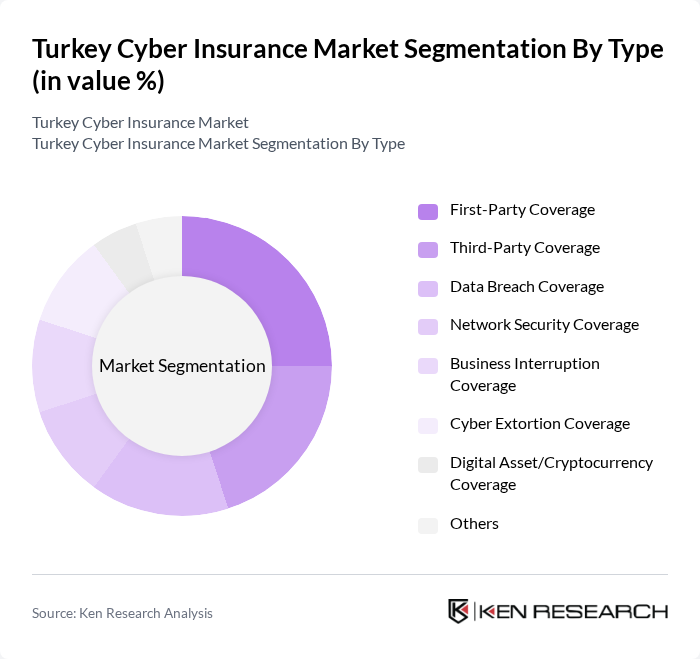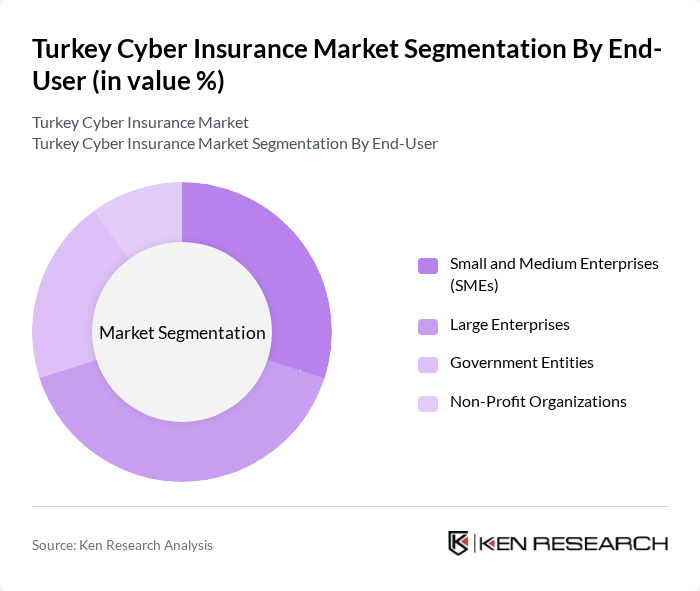Region:Europe
Author(s):Shubham
Product Code:KRAA3630
Pages:94
Published On:September 2025

By Type:The market can be segmented into various types of coverage, including First-Party Coverage, Third-Party Coverage, Data Breach Coverage, Network Security Coverage, Business Interruption Coverage, Cyber Extortion Coverage, Digital Asset/Cryptocurrency Coverage, and Others. Each of these segments addresses specific risks associated with cyber incidents, catering to the diverse needs of businesses. Insurers are increasingly offering tailored products that include risk assessments, incident response services, and coverage for regulatory fines, reflecting the evolving threat landscape and regulatory environment .

By End-User:The end-user segmentation includes Small and Medium Enterprises (SMEs), Large Enterprises, Government Entities, and Non-Profit Organizations. Each of these segments has unique requirements and risk profiles, influencing their purchasing decisions regarding cyber insurance. SMEs are increasingly exposed due to limited cybersecurity resources, while large enterprises and government entities face complex regulatory and operational risks, driving demand for comprehensive and sector-specific coverage .

The Turkey Cyber Insurance Market is characterized by a dynamic mix of regional and international players. Leading participants such as Allianz Sigorta A.?., AIG Sigorta A.?., Zurich Sigorta A.?., Mapfre Sigorta A.?., Anadolu Sigorta, QBE Sigorta A.?., Generali Sigorta A.?., Sompo Sigorta A.?., AXA Sigorta A.?., Chubb Sigorta A.?., HDI Sigorta A.?., Türkiye Sigorta Birli?i (Turkish Insurance Association), Aksigorta A.?., Ergo Sigorta A.?., Groupama Sigorta A.?. contribute to innovation, geographic expansion, and service delivery in this space.
The Turkey cyber insurance market is poised for significant evolution, driven by increasing digitalization and regulatory pressures. As businesses continue to embrace digital transformation, the demand for comprehensive cyber insurance solutions will rise. Additionally, the integration of advanced technologies, such as AI for risk assessment, will enhance the effectiveness of insurance products. The market is expected to witness innovative offerings tailored to specific sectors, ensuring that organizations can adequately protect themselves against evolving cyber threats and compliance requirements.
| Segment | Sub-Segments |
|---|---|
| By Type | First-Party Coverage Third-Party Coverage Data Breach Coverage Network Security Coverage Business Interruption Coverage Cyber Extortion Coverage Digital Asset/Cryptocurrency Coverage Others |
| By End-User | Small and Medium Enterprises (SMEs) Large Enterprises Government Entities Non-Profit Organizations |
| By Industry | Financial Services (BFSI) Healthcare Retail & E-commerce Manufacturing Technology & IT Telecommunications Energy & Utilities Industrial & Defense Others |
| By Coverage Type | Comprehensive Coverage Limited Coverage Standalone Cyber Insurance Packaged/Integrated Policies |
| By Distribution Channel | Direct Sales Brokers Online Platforms Bancassurance |
| By Policy Duration | Short-Term Policies Long-Term Policies |
| By Policy Limit | Low Limit Policies Medium Limit Policies High Limit Policies |
| Scope Item/Segment | Sample Size | Target Respondent Profiles |
|---|---|---|
| Financial Services Cyber Insurance | 100 | Risk Managers, Compliance Officers |
| Healthcare Sector Cyber Coverage | 80 | IT Security Directors, Insurance Brokers |
| Retail Industry Cyber Risk Management | 70 | Operations Managers, IT Managers |
| Manufacturing Cyber Insurance Needs | 50 | Chief Information Officers, Risk Assessment Specialists |
| SME Cyber Insurance Awareness | 60 | Business Owners, IT Consultants |
The Turkey Cyber Insurance Market is valued at approximately USD 185 million, reflecting significant growth driven by increasing cyber threats, heightened awareness of cybersecurity risks, and the rapid digitalization of the economy.